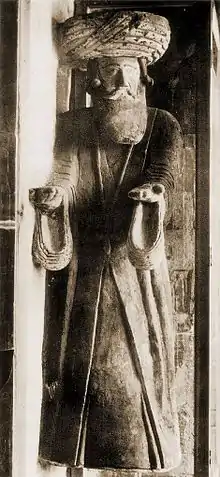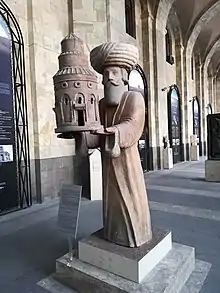| Gagik I | |||||
|---|---|---|---|---|---|
 The statue of Gagik I found in Ani by Nicholas Marr's excavations in 1906 | |||||
| King of Armenia | |||||
| Reign | 989-1017/20 | ||||
| Predecessor | Smbat II | ||||
| Successor | Hovhannes-Smbat | ||||
| Burial | |||||
| Spouse | Katranide | ||||
| Issue | Hovhannes-Smbat Ashot IV Khushush[a] | ||||
| |||||
| Dynasty | Bagratuni | ||||
| Father | Ashot III | ||||
| Mother | Khosrovanuysh | ||||
| Religion | Armenian Apostolic | ||||
Gagik I (Armenian: Գագիկ Ա) was the king of Armenia who reigned between 989 and 1020,[2] under whom Bagratid Armenia reached its height,[3] and "enjoyed the accustomed experience of unbroken peace and prosperity."[4]
Rule
.jpg.webp)
It is unknown when Gagik I was born. He succeeded his brother Smbat II in 989. He followed the footsteps of his predecessors in building churches and religious buildings in the capital Ani.[5] Using the favorable economic conditions of Armenia, Gagik increased the size of the army up to 100,000 soldiers. He subsequently united various Armenian provinces to Bagratid Armenia, including Vayots Dzor, Khachen, Nakhichevan and the city of Dvin.[6] He made alliances with Gurgen of Iberia and Bagrat III of Georgia, whose armies defeated Mamlan, the emir of Khorasan, in 998 in the village of Tsumb, northeast of Lake Van.[7] Under Gagik I, the Kingdom of Armenia extended from Shamkor to Vagharshakert and Kura River to Apahunik near Lake Van. The country's economy, culture and foreign trade developed; Ani, Dvin, and Kars flourished.[6] He has joined to his territory Vanadzor, the most part of Artsakh (Khachen) and two main provinces of Vaspurakan: Kogovit and Ttsaghkotn.
After his death, his elder son, Hovhannes-Smbat, was crowned king while his younger son, Ashot, rebelled against Smbat and proclaimed his independence in the Kingdom of Lori-Dzoraget.[6]
Archaeological finds

One of Gagik's principal projects was the Church of St. Gregory in Ani (1001–10), loosely modeled on Zvartnots. During Nicholas Marr's excavation of the city's ruins in 1906, a 2.26-meter high statue of King Gagik holding a model of his church was found in fragments.[8] It shows Gagik wearing a turban on his head and a khalat, which indicates that he was recognized by the Abbasid Caliphate.[6] The statue was originally located in a niche high up in the north facade of the church. It was lost in uncertain circumstances at the end of the First World War. Only a few photographs record its appearance. A surviving fragment of the statue is now in the Erzurum archaeological museum. Exactly how, and when, it got there is unknown. According to the museum staff it was found somewhere in the vicinity of Erzurum and the finder brought it to the museum by car.[8]
Notes
^ a: Betrothed to King Senekerim-Hovhannes Artsruni of Vaspurakan.
References
- ↑ Manuk-Khaloyan, Armen, "In the Cemetery of their Ancestors: The Royal Burial Tombs of the Bagratuni Kings of Greater Armenia (890-1073/79)," Revue des Études Arméniennes 35 (2013), pp. 150, 162, 167, 172-73.
- ↑ (in Russian) Yuzbashyan, Karen, "К хронологии правления Гагика I Багратуни," Antichnaya Drevnost i Srednii Veka 10 (1973), pp. 195-97.
- ↑ Garsoïan, Nina G. "Gagik I," Oxford Dictionary of Byzantium. Oxford: Oxford University Press, 1991, vol. 2, pp. 813-14.
- ↑ Chahin, M. (2001). The Kingdom of Armenia: A History (2. rev. ed.). Richmond, Surrey: Curzon. p. 231. ISBN 9780700714520.
- ↑ (in Armenian) Arakelyan, Babken N., "Բագրատունյաց թագավորույունը X դարի վերջին և XI դարի սկզբներին" [The Bagratuni Kingdom from the Late Tenth to the Early Eleventh Centuries] in Հայ Ժողովրդի Պատմություն [History of the Armenian People], eds. Tsatur Aghayan et al. Yerevan: Armenian Academy of Sciences, 1976, vol. 3, pp. 134-140.
- 1 2 3 4 (in Armenian) Arakelyan, Babken. «Գագիկ Ա» [Gagik I]. Armenian Soviet Encyclopedia. Yerevan: Armenian Academy of Sciences, 1976, vol. 2, p. 637.
- ↑ Madelung, Wilfred. "The Minor Dynasties of Northern Iran," in The Cambridge History of Iran, ed. Richard N. Frye. Cambridge: Cambridge University Press, 1975, vol. 4, p. 237.
- 1 2 "The Statue of King Gagik". VirtualAni. Retrieved 31 January 2014.